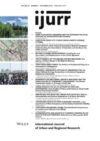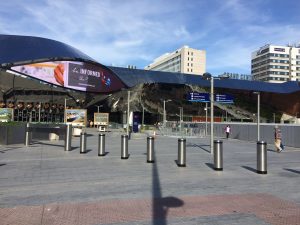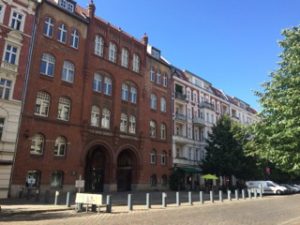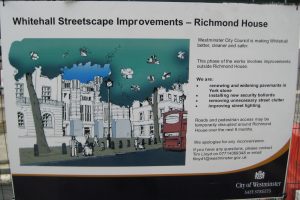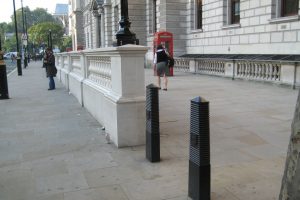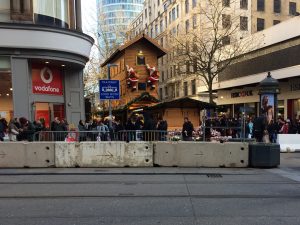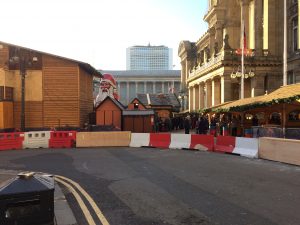In 2004 I published a review paper in IJURR entitled Rings of Steel, Rings of Concrete and Rings of Confidence: Designing out Terrorism in Central London pre and post September 11th (Coaffee, 2004) that reflected upon the rapid growth of militarized urbanism in the wake of 9/11. Whilst this piece spotlighted contemporary events as they unfolded, it was a ‘point in time’ observation. It was clear that the urban security implications of 9/11 were in their first wave and that much more sophisticated terrorist attacks were emerging, with non-orthodox targeting and tactical preferences, necessitating subsequent counter-responses that could anticipate these and advance new methods of defence. Much has indeed changed in terms of the characteristics of the sites that are targeted by terrorists, and, as a result, in the form and function of the cityscape as threat levels remain high. For example, Europol – the European Union’s law enforcement agency – reported that over 200 failed, foiled and completed terrorist attacks took place in the EU in 2015 alone. In the early months of 2016 attacks in Paris, Brussels, Istanbul, Nice and Munich have highlighted the perpetual threat faced by cities in the never-ending ‘war on terror’ and resulted in the highest number of terrorist deaths since 2004 (on the whole Western Europe accounts for only 6% of all worldwide terrorist deaths so far in 2016). This is a ‘long war’ that has undergone a number of important urban evolutions linked to targeting preferences, innovative security aesthetics and the advance of new policy rhetorics. These are explored below with a focus upon Western cities.
The targeting of soft spaces
Defending vulnerable urban spaces of Western cities against the ever-changing nature of terrorism has long occupied state security services but until 9/11 the selective nature of targets under threat meant that this seldom had major impacts upon everyday life in the city, or upon the practice of built environment professionals. As we have seen from the recent attacks across continental Europe, the modus operandi of terrorists has changed significantly since the millennium. Vehicle-borne improvised explosive devices (VBIED – car or lorry bombs) targeting major financial or political centres have been replaced by person-borne improvised explosive devices (PBIEDs) – especially suicide attacks – and subsequently Fedayeen-style mass shooting attacks and the deliberate targeting of crowds with fast-moving vehicles.
Consequently, traditional territorial counter-terrorism approaches – the construction of defensive cordons, ‘security zones’ or ‘rings of steel’ where access is restricted and surveillance significantly enhanced – are largely inadequate and have been rethought given the increased appreciation of the changing threat (see Graham, 2002; Hollander and Whitfield, 2005). Although debates continue about the relationship between new and traditional threats, the methods and tactics adopted by terror groups are increasingly novel, innovative and focused on mass casualty strikes or multiple coordinated attacks. Such attacks are tactically aimed at soft targets such as hospitals, sports stadia, hotels, schools, shopping promenades and more generally crowded places (Coaffee et al., 2008a). These targets of choice – crowded areas – have features in common (most notably their easy accessibility) that cannot be altered without radically changing citizen experience of such, largely, public places.
Security aesthetics
Over the last decade processes of urban revitalization has become increasingly influential in urban policy-making, emphasizing inclusivity, liveability and accessibility. However, these ‘quality-of-life issues’ sit uneasily beside issues of urban security, which can easily give rise to physical, technological and legislative strategies of urban counter-terrorism and social control (Coaffee, 2005). Attacks against ‘soft’ public spaces have necessitated that in ‘at risk’ areas security becomes part of the urban design process and is proportionate to the risk faced. As illuminated in my 2004 piece, many unrefined and obtrusive security features were almost literally ‘thrown’ around key sites, as security installations needed to be ‘seen to be doing something’— employing features that are relatively effective at stopping vehicles carrying explosives penetrating defined urban spaces (notably reinforced steel barriers, bollards or concrete ‘planters’) – but were not necessarily socially acceptable nor aesthetically pleasing (see Benton-Short, 2007). Moreover, as others have highlighted the ‘guns, guards, gates’ posture adopted in the immediate wake of 9/11 was in one sense counterproductive owing to the way such measures ‘actually intensify and reinforce public perceptions of siege or vulnerability, and thus heighten the sense of imminent danger and anticipation of attack.’ (Grosskopf, 2009). To improve this process, over recent years, a range of built environment professionals have been encouraged and trained to be involved in security design, working alongside dedicated security professionals, to provide more specialised input into interventions within the public realm.
As a result the initial swathe of security bollards and barriers that littered the landscape of many cities in the wake of 9/11 is slowly giving way to more subtle alterations in the urban landscape that seek to balance the need to provide effective physical security with aesthetic and social impacts considerations (although in many cases bollard-type solutions still prevail or have been retained – see Figures 1 and 2). It is now often argued that the introduction of additional security features should not, where possible, negatively impact upon everyday economic and democratic activities. This realisation has led to a predominant view that security features should be as unobtrusive as possible. As one commentator noted ‘we might live in dangerous times, but they don’t have to be ugly ones too’ (Bayley, 2007). In response to this challenge we now see security features being increasingly camouflaged and subtlety embedded within the urban landscape so that to the general public they do not obviously serve a counter-terrorism purpose. Examples of such ‘stealthy’ features include ornamental or landscaped measures such as balustrades or artwork erected as part of public-realm ‘streetscape’ improvements that have deliberately designed-in security more attractively and inconspicuously whilst still providing a hostile vehicle mitigation (HVM) functionality, with designs capable of stopping a 7 tonne truck travelling at 50 miles per hour (Coaffee et al., 2009: see Figures 3 and 4). This, as one commentator has noted, potentially ‘represents the future of the hardening of public buildings and public space – soft on the outside, hard within, the iron hand inside the civic velvet glove’ (Boddy, 2007).
- 1: HVM barriers outside of Birmingham New Street Station, UK
- 2: HVM barriers restricting access to a Jewish school in North East Berlin, Germany.
- 3: Security balustrades in Whitehall in London’s ‘Government security zone’ designed to blend into the existing cityscape and mask their counter-terrorism function
- 4: Bollards as part of streetscape improvements in Whitehall. All photos by J. Coaffee.
Reframing counter-terrorism as resilience
The obsolescence of traditional methods of counter-terrorism in the context of new terrorist threats has, in many locations, led to a new lexicon being used to characterize the emerging approaches being adopted by urban security managers, based upon the concept of resilience. Whilst the ‘protective’ design measures highlighted above form one important strand of possible counter-terrorism intervention – with ‘resilient design’ becoming a well-used rhetoric associated with interventions that seek to mitigate the risks of terrorism (and other urban risks such as flooding) – an overarching use of resilience in policy discourse has been to frame national security policies with an emphasis is on the changing risk landscape and the need to prepare for future and unpredictable terrorist threats. In this new context resilience has emerged as perhaps the central organising metaphor within both the urban policymaking process and in the expanding institutional framework of national security and emergency preparedness (see for example Vale and Campanella, 2005; Coaffee, 2009; Coaffee and Lee, 2016). Post-9/11, national security policy in the West has increasingly adopted proactive and pre-emptive solutions where 100% security cannot be guaranteed and where urban security is scrutinised through the lens of ‘resilience’. Over time this has sought to reframe crises and the ‘inevitable’ terrorist attack as an opportunity to proactively confront threats within a positive language of assurance and comfort (White and O’Hare, 2014)and as a means to improve the capability of preparing for, responding to and recovering from a terrorist attack.
In practice, the drive for security-driven urban resilience has drawn an ever-increasing number of local, public-facing individuals and agencies into resilience roles. Resilience has become central to the discussion of shifting social and political histories and to the framework of agents and agencies operating under the guise of national security. For many, the governance of resilience, and particularly the interactions between citizen and state, is therefore progressively ‘responsibilising’: putting the onus for preventing and preparing for urban security challenges onto institutions, professions, communities and individuals rather than the state, the traditional provider of citizens’ security needs (Coaffee et al., 2008).
The limits of protective counter-terrorist security
Evolving urban security/resilience strategies seeking to counter terrorism are attempting to balance the twin aims of security effectiveness and social and political acceptability. Since 9/11 a much more proactive and integrated approach to protective ‘designed-in’ counter-terrorist security in cities has emerged where instead of reacting at pace, a more reflexive response is now possible, which accounts for issues such as proportionality and aesthetics of design, as well as developing a strategic framework whereby many more stakeholders are given responsibility for delivering the agenda (Coaffee, 2010). Protective counter-terrorism is no longer just a police and security services issues as many professional and practice communities, and the general public, are being enrolled in the fight against terrorism. This of course raises a series of issues of professional ethics as well as a broader, age old question of: what is ‘normal’ urban security? (See for example, Graham, 2010). Over time the dynamic nature of the terrorist threat, and the occurrence of particular incidents, has meant that counter-terrorist activity and the form of military urbanism deployed have remained in flux. In many Western cities it has moved from a temporary measure to an ever-present technology of Government and has been effectively normalised within many urban contexts where the risk of attack is perceived to be high and where states of emergency exist as an almost permanent condition. The international reaction to the attack on a Berlin market in December 2016 served to illuminate that the difficulties in balancing reactive and proactive counter-terrorism elements within the built environment and in many areas have brought us full circle back to immediate post-9/11 responses. In the wake of Berlin, the media has been awash with security experts promoting the virtues of hostile vehicle mitigation measures to restrict access to Trojan vehicle attacks whilst, on the ground, markets and other public spaces across Europe have put in place makeshift security and extra visible policing to quell the fears of the public. As illustrated below in Figure 5 and 6 those in charge of security at the annual German market in Birmingham, UK, installed a series of concreate blockers, wooden crates filled with earth (although a number were empty) and plastic barriers as temporary security measures.
- Figure 5: Temporary security measures in Birmingham UK
- Figure 6: HVM barriers outside of Birmingham New Street Station, UK
Jon Coaffee is a Professor in Urban Geography in the Department of Politics and International Studies at the University of Warwick where he directs the Resilient Cities Laboratory. He is an international expert in counter-terrorism, security and urban resilience. His work includes Terrorism, Risk and the City (2003) The Everyday Resilience of the City: How Cities Respond to Terrorism and Disaster (2008) Terrorism, Risk and the Global City – towards urban resilience (2009) Sustaining and Securing the Olympic City: reconfiguring London for 2012 and beyond (2011) and Urban Resilience: planning for risk crisis and uncertainty (2016).
All essays on The City at War: Reflections on Beirut, Brussels and Beyond
The City at War
Rivke Jaffe
When the Pursuit of National Security Produces Urban Insecurity
Saskia Sassen
Diversifying Urban Studies’ Perspectives on the City at War
Mona Harb
A Balanced Response? The Quest for Proportionate Urban Security
Jon Coaffee
War, Crisis Cities, and Urban Research
Miriam Greenberg
Published online 2017
Related IJURR articles on the City at War
Urban Security from Warfare to Welfare
Jennifer S. Light
Introduction: Symposium on Urban Terror
Harvey Molotch
Cities and the ‘War on Terror’
Stephen Graham
Security or Safety in Cities? The Threat of Terrorism after 9/11
Peter Marcuse
When Life Itself is War: On the Urbanization of Military and Security Doctrine
Stephen Graham
Guerrilla‐style Defensive Architecture in Detroit: A Self‐provisioned Security Strategy in a Neoliberal Space of Disinvestment
Kimberley Kinder
© 2017 THE AUTHOR. INTERNATIONAL JOURNAL OF URBAN AND REGIONAL RESEARCH, PUBLISHED BY JOHN WILEY & SONS LTD UNDER LICENSE BY URBAN RESEARCH PUBLICATIONS LIMITED
This is an open access article under the terms of the Creative Commons Attribution-NonCommercial-NoDerivs License, which permits use and distribution in any medium, provided the original work is properly cited, the use is non-commercial and no modifications or adaptations are made.
